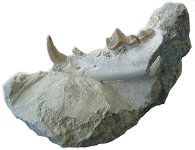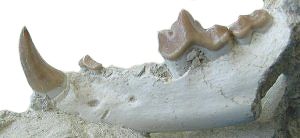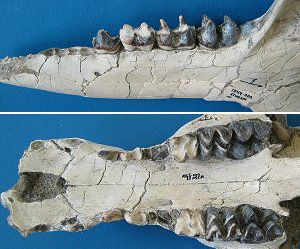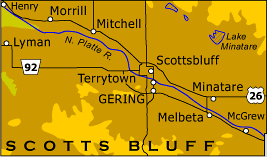
Nebraska County Fossils
Scotts Bluff
< Vertebrate Paleontology Home
A virtual journey through the Museum's vertebrate paleontology collection.
Merychyus siouxensis, Oreodont
Family: Merycoidodontidae
Geologic age: Early Miocene (L. Arikareean), about 21 million years old
Year fossil collected: 1994


Oreodonts were sheep-like artiodactyls (even-toed hoofed mammals) and are among the most common fossils found in Nebraska. This articulated specimen of the small oreodont Merychyus is another of the important specimens found by the Highway Salvage Paleontology Program, a joint effort between the Nebraska Department of Roads and the University of Nebraska State Museum.
Cephalogale, Primitive bear
Family: Ursidae
Geologic age: Early Miocene (Late Arikareean), about 21 million years old
Year fossil collected: 2000


This Eurasian immigrant is the earliest member of the Hemicyoninae, a group of bears that became extinct at the end of the Miocene. Although usually very rare, several well-preserved specimens have been recovered by the Highway Salvage Paleontology Program from a site known as "Millennium's End Quarry" in Scotts Bluff County.
Arretotherium, "Indescribable beast"
Family: Anthracotheridae
Geologic age: Early Miocene (L. Arikareean), about 21 million years old
Year fossil collected: 2000


Anthracotheres are hippo-like artiodactyls that probably had an aquatic lifestyle. They are often abundant in ancient river deposits that produce fossils of other "woodland" animals, but rare in deposits formed in prairie habitats. Arretotherium is the last North American genus of anthracothere and became extinct about 18 million years ago.
Geological Ages of Rock Formations

| Q | Pleistocene ("Ice Age") Sands, gravels, silts overlay much of the county (not shown) Pleistocene sands, gravels and silts overlay much of Nebraska and often conceal the bedrock beneath. These "Ice Age" deposits often produce the remains of mammoths, bison, horses, musk oxen, elk and other familiar mammals. Small fossils, especially, are important indicators of the climate at the time of deposition. |
| Tm | Tertiary, Miocene, Hemingford/Arikaree Group, 15-28 million years old The Hemingford/Arikaree group includes the Miocene Sheep Creek, Upper Harrison, Harrison, Monroe Creek and Gering Formations. These rocks typically form the higher relief ridges as seen throughout the Pine Ridge area of Nebraska. These fine to medium grained sandstones contain considerable volcaniclastic material and indicate high volcanic activity in the west. Fossils from these rocks document the transition from a forest habitat to an open grassland habitat. |
| To | Tertiary, Oligocene, White River Group, 28-40 million years old The White River Group rocks include the Chadron and Brule Formations often form large expanses of low to medium-relief badlands typical of western Nebraska (Toadstool Park) and South Dakota (Big Badlands). Siltstones and very fine sandstones dominate these units. The White River Group rocks preserve the early history of horses, rhinos and camels, all of which originated in North America. The habitats across much of the state at the time were distinctly un-Nebraskan, with low-crowned browsing mammals (forest dwellers) and their predators composing the dominant fauna. |
| Kf | Cretaceous, Fox Hills Formation, 65-70 million years old The Fox Hills Formation represents the end of the Cretaceous mid-continental sea in Nebraska and is composed of sandstone and silty sandstone. Its exposure in Nebraska is limited to a small area on our western border Wyoming. To our knowledge, the Fox Hills Formation has produced no vertebrate fossils in Nebraska. |





